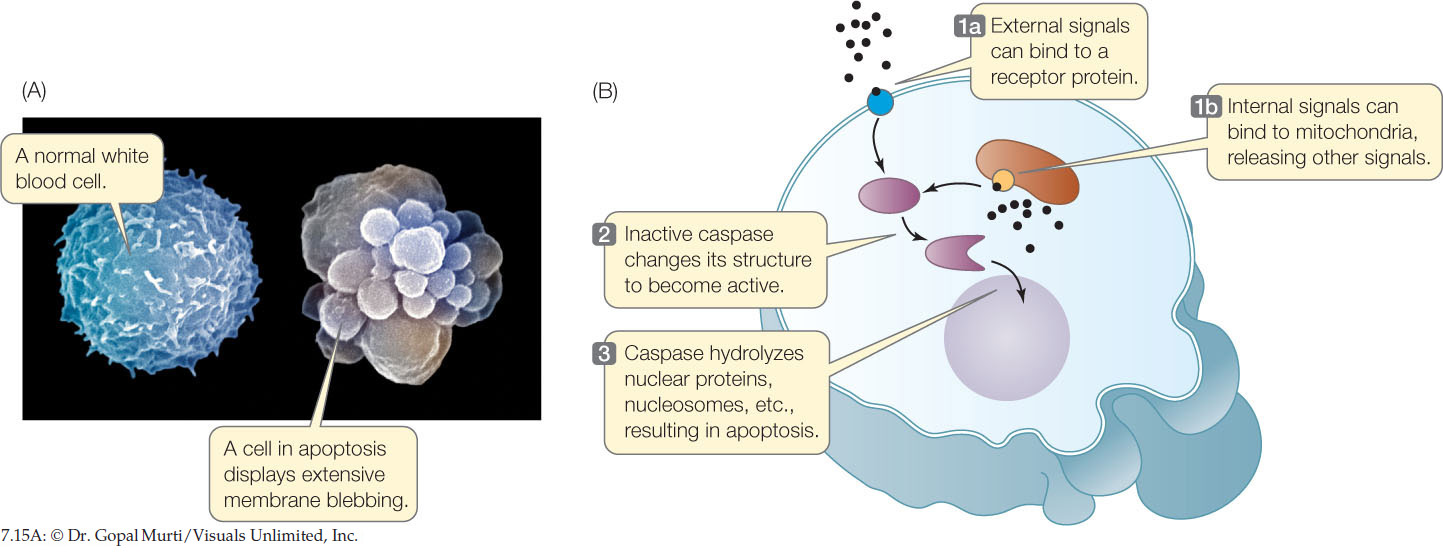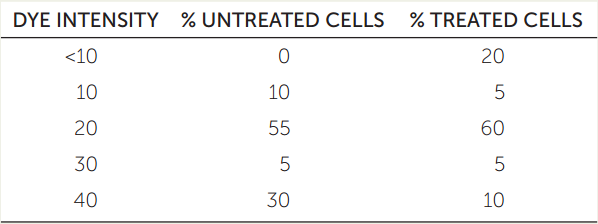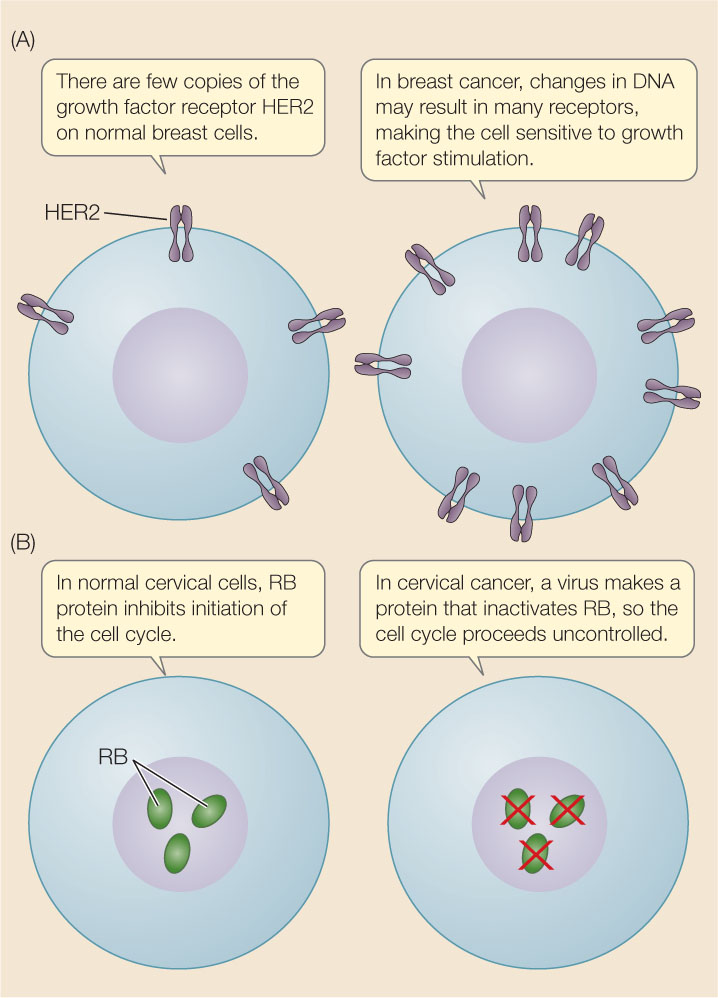Concept 7.5: Programmed Cell Death Is a Necessary Process in Living Organisms
Cells die in one of two ways. The first type of cell death, necrosis, occurs when cells are damaged by mechanical means or toxins, or are starved of oxygen or nutrients. These cells often swell up and burst, releasing their contents into the extracellular environment. This process often results in inflammation (see Concept 39.1).
More typically, cell death is due to apoptosis (Greek, “falling apart”). Apoptosis is a genetically programmed series of events that result in cell death. Why would a cell initiate apoptosis, which is essentially cell suicide? In animals, there are two possible reasons:
147
- The cell is no longer needed by the organism. For example, before birth, a human fetus has weblike hands, with connective tissue between the fingers. As development proceeds, this unneeded tissue disappears as the cells undergo apoptosis in response to specific signals.
- The longer cells live, the more prone they are to genetic damage that could lead to cancer. This is especially true of epithelial cells on the surface of an organism, which may be exposed to radiation or toxic substances. Such cells normally die after only days or weeks and are replaced by new cells.
The events of apoptosis are similar in many organisms. The cell becomes detached from its neighbors, it hydrolyzes its DNA into small fragments, and forms membranous lobes, or “blebs,” that break up into cell fragments (FIGURE 7.15A). In a remarkable example of the economy of nature, the surrounding living cells usually ingest the remains of the dead cell by phagocytosis. The remains are digested in the lysosomes, and the digestion products are recycled.

Apoptosis is also used by plant cells in an important defense mechanism called the hypersensitive response. Plants can protect themselves from disease by undergoing apoptosis at the site of infection by a fungus or bacterium. With no living tissue to grow in, the invading organism is not able to spread to other parts of the plant. Because of their rigid cell walls, plant cells do not form blebs the way animal cells do. Instead, they digest their own cell contents in the vacuole and then release the digested components into the vascular system.
Despite these differences between plant and animal cells, they share many of the signal transduction pathways that lead to apoptosis. Like the cell division cycle, programmed cell death is controlled by signals, which may come from inside or outside the cell. Internal signals may be linked to the age of the cell or the recognition of damaged DNA. External signals can be detected by receptors in the cell membrane, and in turn they activate signal transduction pathways. Both internal and external signals lead to the activation of a class of enzymes called caspases in animals or of a functionally similar class of enzymes in plants. These enzymes hydrolyze target proteins in a cascade of events. The cell dies as the caspases hydrolyze proteins of the nuclear envelope, nucleosomes, and cell membrane (FIGURE 7.15B).
APPLY THE CONCEPT: Programmed cell death is a necessary process in living organisms
The DNA content of an individual cell can be measured by applying a DNA-specific dye to the cell and then passing it through an instrument that measures the staining intensity. A new drug was tested on a population of rapidly dividing tumor cells, and the DNA contents of the treated cells were analyzed and compared with those of untreated cells:a

- Plot percentage of cells versus dye intensity for the untreated and treated cells.
- Explain the data for the untreated cells. Which cells are in G1? What do the data indicate about how much time cells spend in G1 relative to other phases?
- Explain the data for treated cells and compare them with untreated cells. At what stage of the cell cycle do you think the new drug acts?
a Author’s own, unpublished data.
148
CHECKpoint CONCEPT 7.5
- What are some differences between apoptosis and necrosis?
- Give examples of situations in which apoptosis occurs in animals and in plants.
- In the worm Caenorhabditis elegans the fertilized egg divides by mitosis to produce 1,090 somatic cells. But the adult worm has only 959 cells. What happens to the 131 other cells formed during worm embryo development? What might happen if the 131 cells did not undergo this process?
Question 7.2
How does infection with HPV result in uncontrolled cell reproduction?
ANSWER Human papillomavirus (HPV) stimulates the cell cycle when it infects tissues lining the cervix. It does this by “hijacking” the regulatory mechanisms that control the cell cycle (Concept 7.3). There are two types of proteins that regulate the cell cycle:
- Oncogene proteins are positive regulators of the cell cycle in cancer cells. They are derived from normal positive regulators that have become mutated to be overly active, or that are present in excess, and they stimulate the cancer cells to divide more often than normal cells. An example of an oncogene protein is the growth factor receptor in a breast cancer cell (FIGURE 7.16A). Normal breast cells have relatively low numbers of the growth factor receptor human epidermal growth factor receptor 2 (HER2). So the growth factor does not normally find many receptors with which to bind and initiate cell division. In about 25 percent of breast cancers, a DNA change results in the increased production of HER2. This results in positive stimulation of the cell cycle, and a rapid proliferation of cells with the altered DNA.
 Figure 7.16: Molecular Changes Regulate the Cell Cycle in Cancer Cells In cancer cells, oncogene proteins become active (A) and tumor suppressor proteins become inactive (B).
Figure 7.16: Molecular Changes Regulate the Cell Cycle in Cancer Cells In cancer cells, oncogene proteins become active (A) and tumor suppressor proteins become inactive (B). - Tumor suppressors are negative regulators of the cell cycle in normal cells, but in cancer cells they are inactive. An example is the retinoblastoma (RB) protein that acts at R (the restriction point) in G1 (see Figure 7.8). When RB is active the cell cycle does not proceed, but it is inactive in cancer cells, allowing the cell cycle to occur (FIGURE 7.16B). This is where HPV hijacks the system. When it infects cells lining the cervix, HPV causes the synthesis of a protein called E7, which has a three-dimensional shape that just fits into the protein-binding site of RB, thereby inactivating it. With no active RB to prevent it, cell division proceeds. Uncontrolled cell reproduction is a hallmark of cancer—and so cervical cancer begins.
Most tumors are treated by surgery. But when a tumor has spread from its original site (a common occurrence, unfortunately), surgery does not cure it. Instead, drugs—chemotherapy—are used. Generally, these drugs stop cell division by targeting specific cell cycle events (Concepts 7.2 and 7.3). For example, some drugs block DNA replication (e.g., 5-fluorouracil); others damage DNA, stopping the cells at G2 (e.g., etoposide); and still others prevent the normal functioning of the mitotic spindle (e.g., paclitaxel). Many of these drugs do not kill the cell, but they cause the cell cycle to stop, and the damaged cell is stimulated to undergo apoptosis (Concept 7.5).
A major problem with these treatments is that they target normal cells as well as the tumor cells. They are toxic to tissues with large populations of normally dividing cells such as those in the intestine, skin, and bone marrow (producing blood cells). There is an ongoing search for better and more specific drugs. For example, a drug has been identified that affects the protein produced as a result of the translocation between chromosomes 9 and 22 (Concept 7.4). The drug is rather specific and has been very successful at treating leukemia caused by this translocation.
149
In this chapter we examined the cell cycle and cell division by binary fission and mitosis. We have seen how the normal cell cycle is disrupted in cancer. We also examined meiosis and the production of haploid cells in sexual life cycles. In the coming chapters we will examine heredity, genes, and DNA. In Concept 8.1 we will discuss Gregor Mendel’s studies of heredity and how the enormous power of his discoveries founded the science of genetics.